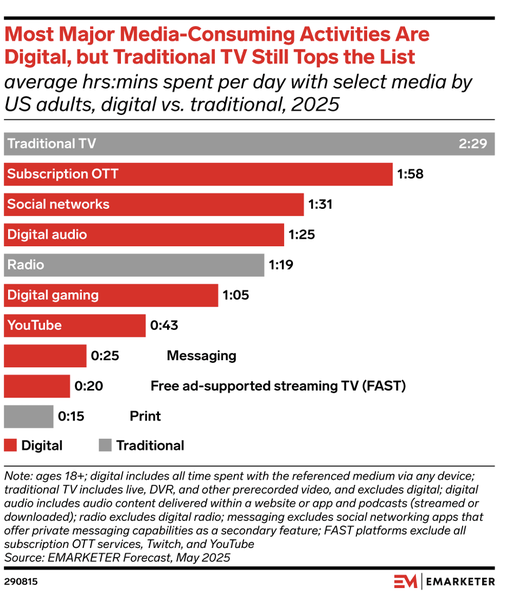Most humans crave organization and structure, although some humans (many of the teenager variety) seem to thrive on chaos. But most humans like to label and box things for ease of reference or use.
It helps identify who we are, or who we want to connect with. In entertainment, for instance, the genre of a movie or series often determines whether we hit play, based on previous experiences with a
director, cast member, or a favored streaming service.
In the integrated marketing world, we label everyone and everything, too. We segment the industry into clients, agencies, vendors, and
platforms. We further subdivide by function: search, production, copywriting, media planning, analytics. The list is endless.
This structure makes it easier to assign responsibilities and
define expertise. But as the media landscape grows ever more fragmented and consumer behaviors evolve, I find myself increasingly questioning the usefulness of its classifications. I was reminded of
that when I saw the stats below, as shared by eMarketer:
advertisement
advertisement

The labels that eMarketer uses are understood, but are they right or
helpful? For instance: why is YouTube separated from free ad-supported streaming TV (FAST)? What's the difference between radio and digital audio?
I frequently watch YouTube content on my
living room television, just as I would any traditional broadcast channel or streaming content. But according to this taxonomy, YouTube is neither “traditional TV” nor “FAST.”
Meanwhile, I call it “watching TV.”
Similarly, I listen to my local PBS station almost exclusively via digital channels: apps on my smart speakers, streaming on my phone, or
through my car’s Bluetooth system. I consider this “listening to the radio,” but using this chart’s labeling, it falls under “digital audio.”.
As an
advertiser, how do you determine the most effective way to reach your audience? The industry labels, once helpful, now create confusion. As consumers migrate from one device or channel to another, the
old labels are no longer useful for strategic planning. For example, a podcast can be experienced live, streamed later, or watched as a video clip on social media. Where does it fit in our labeling
structure -- and does the label actually matter to the consumer?
Some marketers analyze “time spent” versus “budget spent” on touchpoints to determine if they are
allocating sufficient resources to each. However, the labels for these touchpoints are no longer effective, as they overlap and become increasingly ambiguous.
The same challenges apply when
using attribution models or marketing mix modeling, where outcomes are reported according to similar, standardized labels. But if those labels do not take into consideration the way consumers actually
interact with content and advertising, there is real risk of making misguided decisions about where to spend your resources.
I recommend that brands and organizations create their own
definitions of what is and isn’t included in their touchpoint classification, rather than relying on industry labels, which may be irrelevant or incomplete. Create labels that reflect your
specific brand objectives, your unique consumer journey, and the true behaviors of your target audience. In doing so, you ensure that strategies are rooted in your own business’s reality, not in
a structure that does not fit.
And oh, yes, I paraphrased Rishad Tobaccowala’s speech title (“The Future Does Not Fit In The Containers Of The Past”) for the headline of this
article. I could do worse than use his wisdom (and magic).
This post was previously published in an earlier edition of Media Insider.